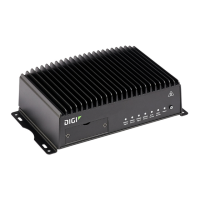Hotspot Hotspot configuration
Digi TransPort WR Routers User Guide
111
See Hotspot LANconfiguration for important information about selecting a LANfor
the hotspot.
b. Set the authentication mode to local-shared-password:
digi.router> hotspot auth-mode local-shared-password
c. Set the login type:
n local-page—Uses an HTMLpage for authentication that is stored locally on
the TransPort device's filesystem, in the hotspot directory. Note that the
hotspot directory is not visible until hotspot has been enabled for the first
time.
i. Set login to local-page:
digi.router> hotspot login local-page
ii. (Optional) Set the local page. Normally, local page should be left
blank, and the TransPort device will use the default
authentication HTMLpage, /hotspot/password.html. If you
upload a custom HTML file that uses a filename other than the
default filename, you should select the custom filename here.
See Upload custom hotspot HTML pages for more information
about creating and uploading custom HTML files.
digi.router> hotspot local-page filename
n remote-url—Uses an HTML page for authentication that is served by a
remote web server.
i. Set login to remote-url:
digi.router> hotspot login remote-url
ii. Set the URL of the remote server that hosts the remote HTML
authentication page. The URL must begin with http:// or
https://.
digi.router> hotspot remote-url url
iii. Add the remote server to either the allowed-domains or
allowed-subnets:
digi.router> hotspot allowed-domains domain-name
Additional servers can be added to the allowed-domains or
allowed-subnets using a comma-separated list. Up to 999
characters are allowed.

